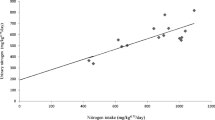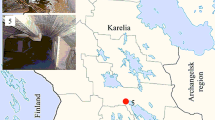Abstract
The peccary digestive tract is characterised by an elaborate forestomach. In order to further characterise the digestive function of peccaries, we report body mass, digestive organ mass, content mass of the gastrointestinal tract compartments and their length and width, as well as liver, parotis and mandibular gland mass. Our data on eleven collared and four white-lipped peccaries suggest that peccaries have a small relative stomach volume compared to other foregut fermenters, which implies a comparatively lower fermentative capacity and thus forage digestibility. The forestomach could enable peccaries to deal, in conjunction with their large parotis glands, with certain plant toxins (e.g. oxalic acid). The finding of sand being trapped in the forestomach blindsacs could indicate a disadvantage of the peccary forestomach design. The relevance of the forestomach to peccaries remains enigmatic.





Similar content being viewed by others
References
Allison MJ, Littledike ET, James LF (1977) Changes in ruminal oxalate degradation rates associated with adaptation to oxalate ingestion. J Anim Sci 45:1173–1179
Altrichter M, Carrillo E, Sáenz J, Fuller T (2001) White-lipped peccary (Tayassu pecari, Artiodactyla: Tayassuidae) diet and fruit availability in a Costa Rican rain forest. Rev Biol Trop 49:1183–1192
Barreto G, Hernandez O, Ojasti J (1997) Diet of peccaries (Tayassu tajacu and T. pecari) in a dry forest of Venezuela. J Zool 241:279–284
Bauchop T, Martucci R (1968) Ruminant-like digestion of the langur monkey. Science 161:698–700
Bravo A, Harms KE, Stevens RD, Emmons LH (2008) Collpas: Activity hotspots for frugivorous bats (Phyllostomidae) in the Peruvian Amazon. Biotropica 40:203–210
Carl G, Brown R (1983) Protozoa in the forestomach of the Collared Peccary (Tayassu tajacu). J Mammal 64:709
Clauss M (2004) A potential interplay of posture, digestive anatomy, density of ingesta and gravity in mammalian herbivores, or why sloths do not rest upside down. Mamm Rev 34:241–245
Clauss M, Lechner-Doll M (2001) Differences in selective reticulo-ruminal particle retention as a key factor in ruminant diversification. Oecologia 129:321–327
Clauss M, Schwarm A, Ortmann S, Alber D, Flach E, Kühne R, Hummel J, Streich WJ, Hofer H (2004) Intake, ingesta retention, particle size distribution and digestibility in the hippopotamidae. Comp Biochem Physiol 139:449–459
Clauss M, Nijboer J, Loermans J, Roth T, Van der Kuilen J, Beynen A (2008) Comparative digesiton studies in wild suids at Rotterdam zoo. Zoo Biol 27:305–319
Comizzoli P, Peiniau J, Dutertre C, Planquette P, Aumaitre A (1997) Digestive utilization of concentrated and fibrous diets by two peccary species (Tayassu peccari, Tayassu tajacu) raised in French Guyana. Anim Feed Sci Technol 64:215–226
Dellow D, Hume I (1982) Studies on the nutrition of macropodine marsupials. IV. Digestion in the stomach and the intestine of Macropus giganteus, Thylogale thetis and Macropus eugenii. Aust J Zool 30:767–777
Foley WJ, von Engelhardt W, Charles-Dominique P (1995) The passage of digesta, particle size, and in vitro fermentation rate in the three-toed sloth. J Zool 236:681–696
Freudenberger D (1992) Gut capacity, functional allocation of gut volume and size distributions of digesta particles in two macropodid marsupials (Macropus robustus robustus and M. r. erubescens) and the feral goat (Capra hircus). Aust J Zool 40:551–561
Gallagher J, Varner L, Grant W (1984) Nutrition of the collared peccary in south texas. J Wildl Manage 48:749–761
Hofmann R, Streich W, Fickel J, Hummel J, Clauss M (2008) Convergent evolution in feeding types: salivary gland mass differences in wild ruminant species. J Morphol 269:240–257
Hume I (1977) Production of volatile fatty acids in two species of wallaby and in sheep. Comp Biochem Physiol 56:299–304
Kay R, Hoppe P, Maloiy G (1976) Fermentative digestion of food in the colobus monkey, Colobus polykomos. Specialia 32:485–487
Knott K, Barboza PS, Bowyer R, Blake J (2004) Nutritional development of feeding strategies in arctic ruminants: digestive morphometry of reindeer, Rangifer tarandus, and muskoxen, Ovibos moschatus. Zoology 107:315–333
Langer P (1978) Anatomy of the stomach of the collared peccary, Dicotyles tajacu. Z Säugetierkd 43:42–59
Langer P (1979) Adaptational significance of the forestomach of the collared peccary, Dicotyles tajacu. Mammalia 43:235–245
Langer P (1988) The mammalian herbivore stomach. Gustav Fischer, Stuttgart
Lentle R, Hume I, Kennedy M, Stafford K, Potter M, Springett B, Haslett S (2002) The histology and morphometrics of the major salivary glands of four species of wallabies (Marsupialia: Macropodiae) from Kawau Island, New Zealand. J Zool 257:403–410
Lochmiller R, Hellgren E, Grant W (1986) Absolute and allometric relationships between internal morphology and body mass in the adult collared peccary, Tayassu tajacu (Tayassuidae). Growth 50:296–316
MacDonald A, Mitchell S, Signorella A, Leus K (2008) Ultrastructural characterization of the epithelium that constitutes the cardiac gland epithelial ´honeycomb´in the stomach of the babirusa (Babyrousa babyrussa). Anim Biol Pathol 331:32–41
McArthur C, Hagerman AE, Robbins CT (1991) Physiological strategies of mammalian herbivores against plant defenses. In: Palo R, Robbins C (eds) Plant defenses against mammalian herbivory. CRC, Boca Raton, pp 103–114
Munn AJ, Banks P, Hume ID (2006) Digestive plasticity of the small intestine and the fermentative hindgut in a marsupial herbivore, the tammar wallaby (Macropus eugenii). Aust J Zool 54:287–291
Munn AJ, Clissold F, Tarszisz E, Kimpton K, Dickman CR, Hume ID (2009) hindgut plasticity in wallabies fed hay either unchopped or ground and pelleted: fiber is not the only factor. Physiol Biochem Zool 82:270–279
Nogueira-Filho S (2005) The effects of increasing levels of roughage on coefficients of nutrient digestibility in the collared peccary (Tayassu tajacu). Anim Feed Sci Technol 120:151–157
Pí JS (1973) Contribution to the ecology of Colobus polykomos satanas (Waterhouse, 1838) of Rio Muni, Republic of Equatorial Guinea. Folia Primat 19:193–207
Pond W, Yen J, Lindvall R, Hill D (1981) Dietary alfalfa meal for genetically obese and lean growing pigs: effect on body weight gain and on carcass and gastrointestinal tract measurements and blood metabolites. J Anim Sci 51:367–373
Schwarm A, Ortmann S, Kühne R, Caspers B, Kelm D, Clauss M (2005) Comparative analysis of physical and chemical characteristics of faeces from free-ranging and captive collared peccaries (Tayassu tajacu). Proceedings of the 9th Congress of the European Society of Veterinary and Comparative Nutrition, Grugliasco-To (Italy), p 103
Schwarm A, Ortmann S, Wolf C, Streich WJ, Clauss M (2008) Excretion patterns of fluid and different sized particle passage markers in banteng (Bos javanicus) and pygmy hippopotamus (Hexaprotodon liberiensis): two functionally different foregut fermenters. Comp Biochem Physiol 150:32–39
Schwarm A, Ortmann S, Wolf C, Streich WJ, Clauss M (2009) Passage marker excretion in red kangaroo (Macropus rufus), collared peccary (Pecari tajacu) and colobine monkeys (Colobus angolensis, C. polykomos, Trachypithecus johnii). J Exp Zool A 311:647–661
Sowls LK (1978) Collared peccary. In: Schmidt JL, Gilbert DL (eds) Big game of North America: ecology and management. Stackpole, Harrisburg, pp 191–205
Sowls LK (1984) The peccaries. The University of Arizona Press, Tucson
Sowls LK (1997) Javelinas and other peccaries: their biology, management, and use, 2nd edn. Texas A&M University Press, College Station
Stevens CE, Hume ID (1995) Comparative physiology of the vertebrate digestive system, 2nd edn. Cambridge University Press, Cambridge
Tyson E (1683) Tajacu seu aper Mexicanus moschiferus, or the anatomy of the Mexico musk-hog, etc. Philos Trans 13:359–385
Warner A (1981) The mean retention time of digesta markers in the gut of the Tammar, Macropus eugenii. Aust J Zool 29:759–771
Wings O, Hatt J, Schwarm A, Clauss M (2008) Gastroliths in a pygmy hippopotamus (Hexaprotodon liberiensis Morton 1984). Senckenb Biol 88:345–348
Acknowledgements
We thank E. Zollinger, N. Brunclik, O.M. Jurado, P. Zerbe, K. Grahl, T. Dörflein, U. Fritzmann, W. Hildebrandt, Z. Mezoe and their colleagues for logistical help and their aid during dissection and J. Peter from the Institute of Veterinary Anatomy of the University of Zurich for producing the illustrations of the gastrointestinal tracts. This study was supported by grants from the Freie Universität Berlin (NaFöG) to AS and the German Science Foundation (DFG) to SO (OR 86/1-1). Sincere thanks to two anonymous reviewers and J. Axtner and S. Albrecht for valuable comments.
Author information
Authors and Affiliations
Corresponding author
Additional information
Communicated by F.-J. Kaup
Rights and permissions
About this article
Cite this article
Schwarm, A., Ortmann, S., Rietschel, W. et al. Function, size and form of the gastrointestinal tract of the collared Pecari tajacu (Linnaeus 1758) and white-lipped peccary Tayassu pecari (Link 1795). Eur J Wildl Res 56, 569–576 (2010). https://doi.org/10.1007/s10344-009-0348-2
Received:
Revised:
Accepted:
Published:
Issue Date:
DOI: https://doi.org/10.1007/s10344-009-0348-2




